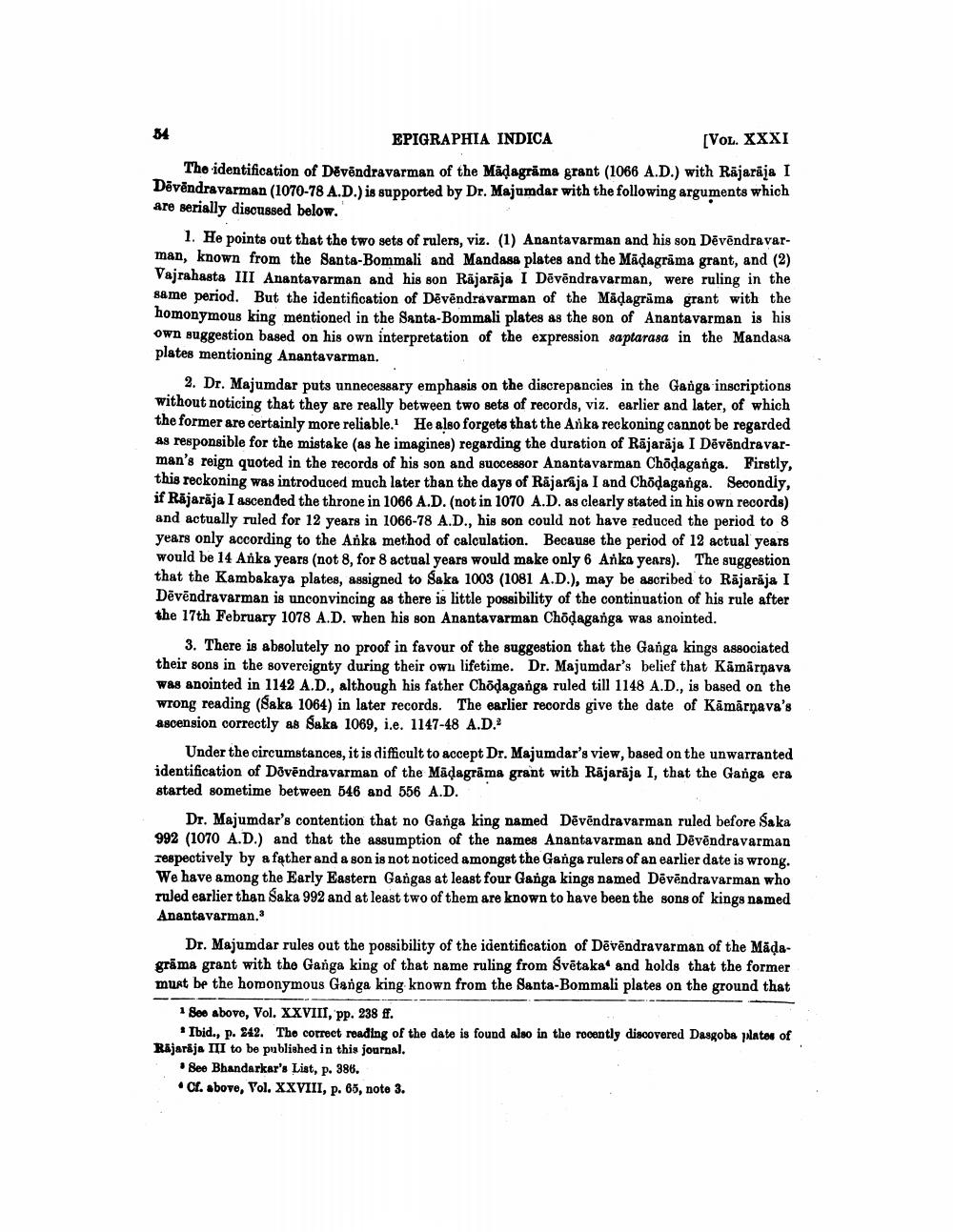________________
54
EPIGRAPHIA INDICA
[VOL. XXXI
The identification of Devendravarman of the Maḍagrama grant (1066 A.D.) with Rājarāja I Devendravarman (1070-78 A.D.) is supported by Dr. Majumdar with the following arguments which are serially discussed below.
1. He points out that the two sets of rulers, viz. (1) Anantavarman and his son Devendravarman, known from the Santa-Bommali and Mandasa plates and the Madagrāma grant, and (2) Vajrahasta III Anantavarman and his son Rajaraja I Devendravarman, were ruling in the same period. But the identification of Devendravarman of the Madagrāma grant with the homonymous king mentioned in the Santa-Bommali plates as the son of Anantavarman is his own suggestion based on his own interpretation of the expression saptarasa in the Mandasa plates mentioning Anantavarman.
2. Dr. Majumdar puts unnecessary emphasis on the discrepancies in the Ganga inscriptions without noticing that they are really between two sets of records, viz. earlier and later, of which the former are certainly more reliable. He also forgets that the Anka reckoning cannot be regarded as responsible for the mistake (as he imagines) regarding the duration of Rājarāja I Devendravarman's reign quoted in the records of his son and successor Anantavarman Chōdaganga. Firstly, this reckoning was introduced much later than the days of Rajaraja I and Chōdaganga. Secondly, if Rajaraja I ascended the throne in 1066 A.D. (not in 1070 A.D. as clearly stated in his own records) and actually ruled for 12 years in 1066-78 A.D., his son could not have reduced the period to 8 years only according to the Añka method of calculation. Because the period of 12 actual years would be 14 Anka years (not 8, for 8 actual years would make only 6 Anka years). The suggestion that the Kambakaya plates, assigned to Saka 1003 (1081 A.D.), may be ascribed to Rajaraja I Devendravarman is unconvincing as there is little possibility of the continuation of his rule after the 17th February 1078 A.D. when his son Anantavarman Chōdaganga was anointed.
3. There is absolutely no proof in favour of the suggestion that the Ganga kings associated their sons in the sovereignty during their own lifetime. Dr. Majumdar's belief that Kämärṇava was anointed in 1142 A.D., although his father Chōdaganga ruled till 1148 A.D., is based on the wrong reading (Saka 1064) in later records. The earlier records give the date of Kamārṇava's ascension correctly as Saka 1069, i.e. 1147-48 A.D.2
Under the circumstances, it is difficult to accept Dr. Majumdar's view, based on the unwarranted identification of Dövendravarman of the Maḍagrama grant with Rajaraja I, that the Ganga era started sometime between 546 and 556 A.D.
Dr. Majumdar's contention that no Ganga king named Devendravarman ruled before Saka 992 (1070 A.D.) and that the assumption of the names Anantavarman and Dēvēndravarman respectively by a father and a son is not noticed amongst the Ganga rulers of an earlier date is wrong. We have among the Early Eastern Gangas at least four Ganga kings named Devendravarman who ruled earlier than Saka 992 and at least two of them are known to have been the sons of kings named Anantavarman.3
Dr. Majumdar rules out the possibility of the identification of Devendravarman of the Mãḍagrāma grant with the Ganga king of that name ruling from Svētaka and holds that the former must be the homonymous Ganga king known from the Santa-Bommali plates on the ground that
1 See above, Vol. XXVIII, pp. 238 ff.
Ibid., p. 242. The correct reading of the date is found also in the recently discovered Dasgoba plates of Rajaraja III to be published in this journal.
See Bhandarkar's List, p. 386.
Cf. above, Vol. XXVIII, p. 65, note 3.




